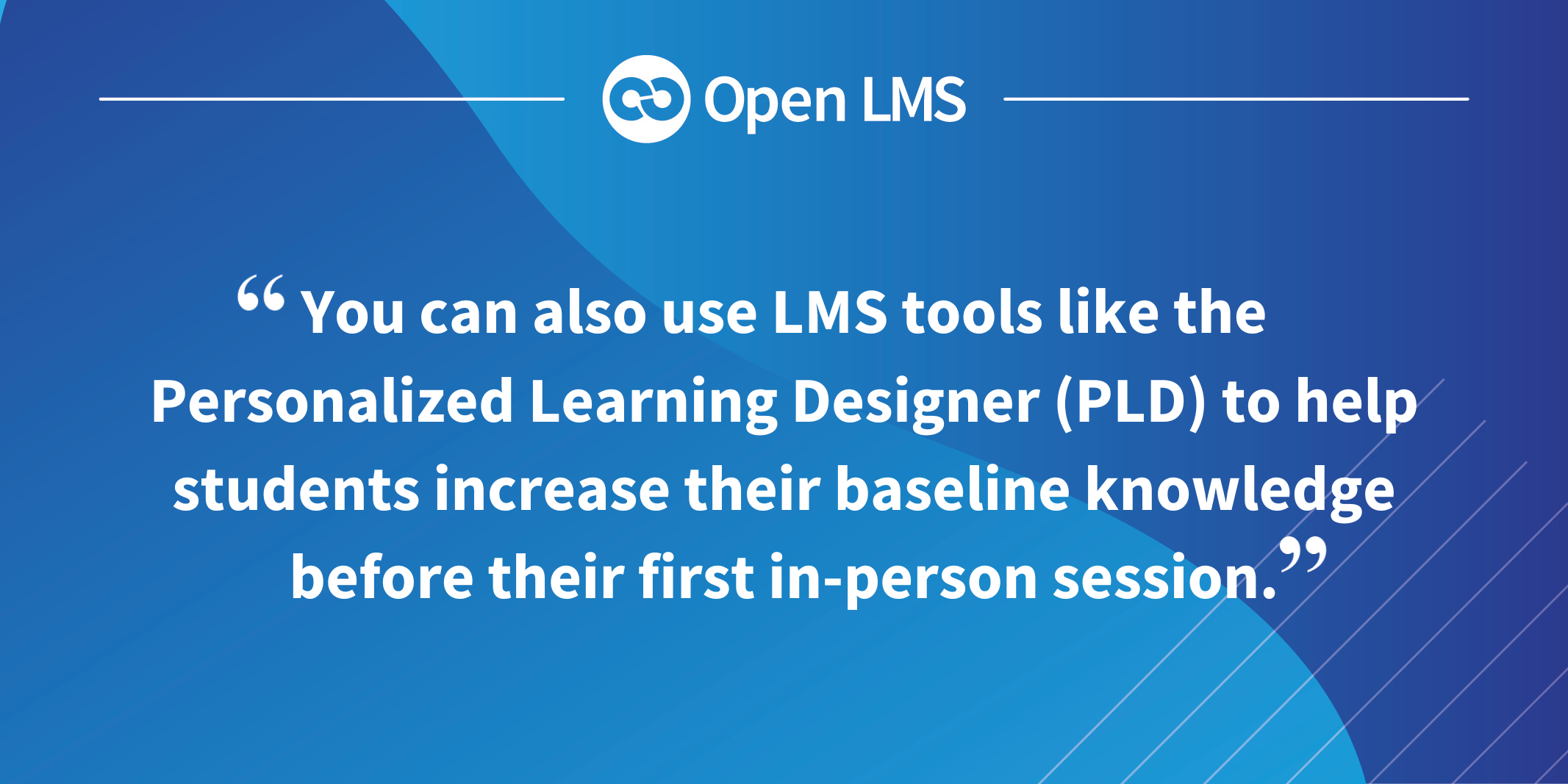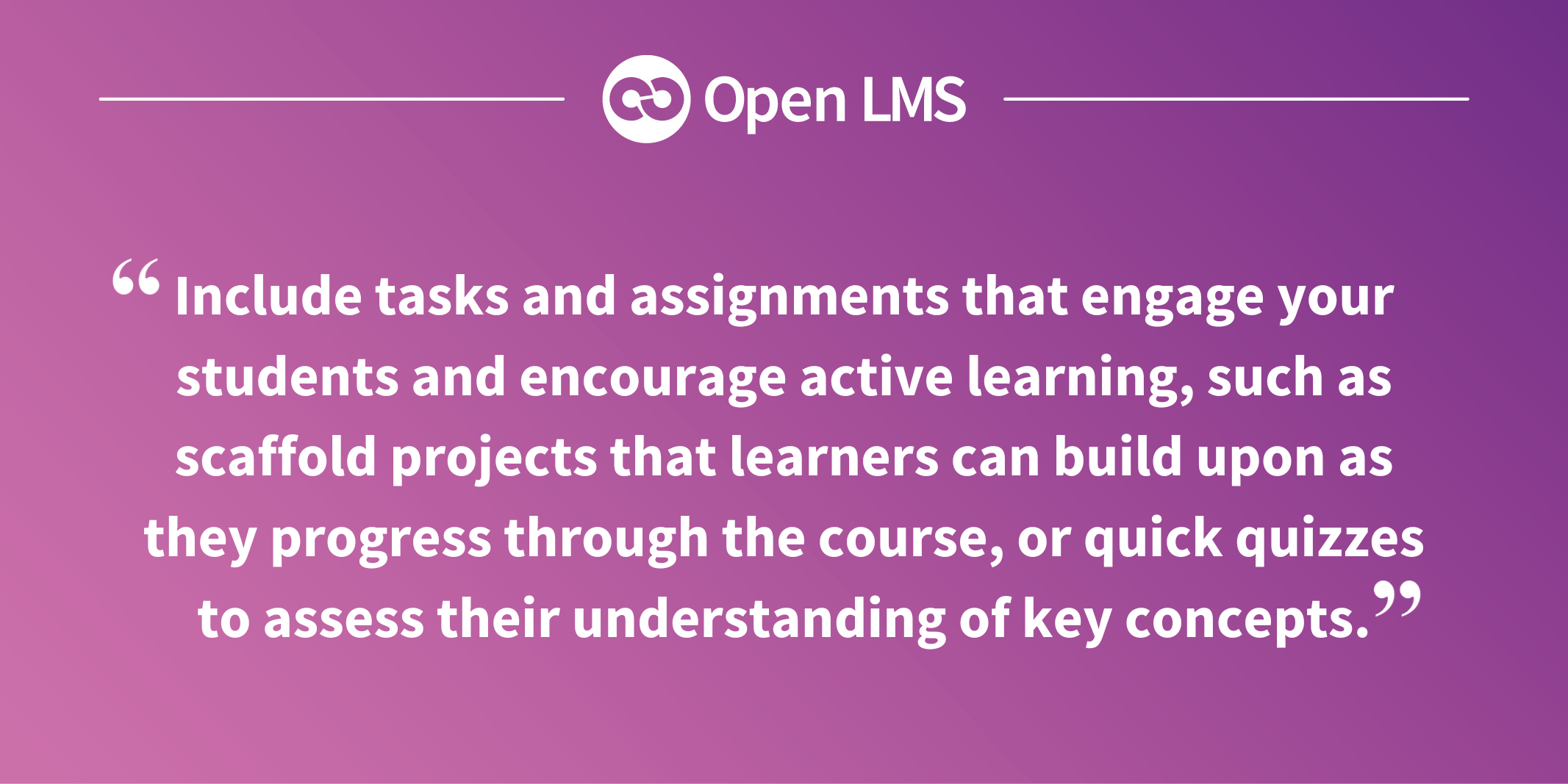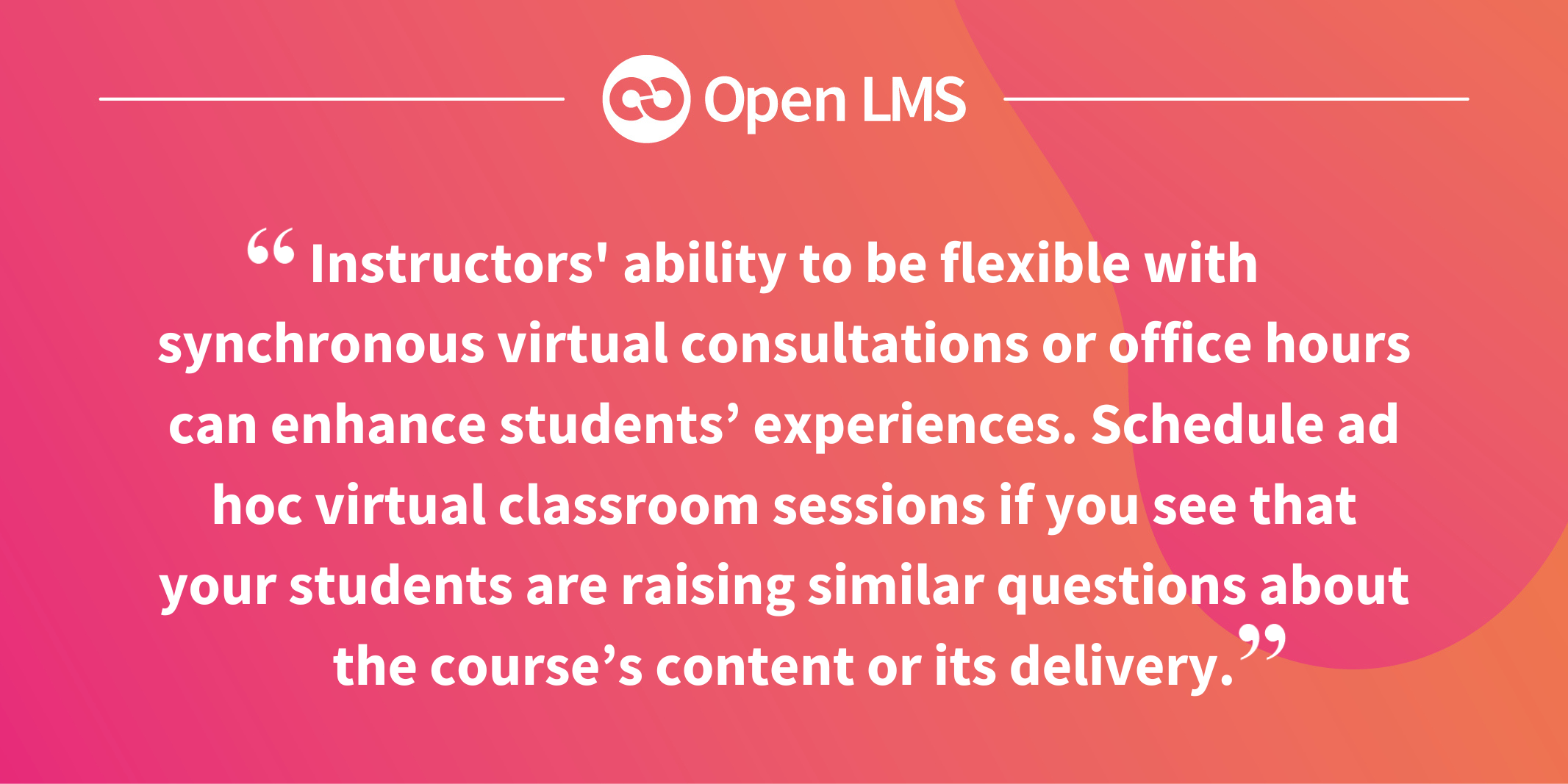Successful Blended Course Design: A Step-by-Step Guide
Blending self-paced online learning with collaborative in-person sessions empowers your students to learn at their own pace and meaningfully engage with course materials. Likewise, a blended approach helps instructors deepen their connections with learners during face-to-face sessions because less time is spent delivering information. Instructors can instead use face-to-face time to facilitate practice activities and discussions that deepen students’ understanding of critical topics.
However, implementing a successful blended learning model requires knowledge of the specifics of synchronous and asynchronous online instruction in conjunction with in-person classroom meetings. Finding the balance between these learning environments is crucial. In this article, we’ll guide you through how to structure your blended online training program. Learn how to take advantage of both learning methods to enhance your courses and better serve your learners.
What Is Blended Learning?
Blended learning is an instructional approach that combines traditional face-to-face experiences with online, often self-paced learning elements. Rather than relying solely on in-person sessions or fully online courses, blended approaches integrate both formats to create a more flexible and effective learning experience.
In a blended model, learners might complete foundational coursework online—such as reading relevant materials, completing quizzes, or watching recorded lectures—before participating in live discussions, group activities, or hands-on training sessions. Instructors at higher education institutions often implement this “flipped classroom” approach to help students engage with content at their own pace. Students can then use in-person time to build deeper connections with their instructors and classmates to put what they’ve learned into practice.
This approach is also useful for organizations that want to scale learning across dispersed teams without losing the benefits of human interaction. For example, an organization might use blended learning to deliver self-paced training content through its LMS to prepare employees for a professional certification exam. The organization can then stage an in-person session before the exam that lets employees practice what they learned in their online training modules. Blending online learning with a live practice session gives those employees the opportunity to fit their coursework into their daily workflows while ensuring they receive the guidance and support necessary to pass their certification exams.
Whether it’s being used for corporate or higher education purposes, blending formats allow for more opportunities to personalize learning, giving today’s learners the tailored experiences they crave. With the right tools and strategy, blended learning can enhance engagement, improve outcomes, and increase the overall efficiency of your academic or training programs.
READ A RELATED CASE STUDY | ‘From Pandemic to Present: How De La Salle Medical and Health Sciences Institute Implemented Blended Learning Programs and Increased Student Enrollment’

Blending Classroom and Online Teaching
While there’s no perfect learning approach, combining online and in-person models comes pretty close. Separately, these learning models each have unique obstacles to overcome. For example, online self-paced training has previously been associated with a lack of live interaction, immediate feedback, and personal support. While personalized learning features in an LMS have certainly enhanced how online learners receive feedback and support, students still benefit from face-to-face interactions with their instructors and classmates. Web conferencing tools help, but they can’t replace the connections that are made during in-person sessions.
Classroom learning also has its drawbacks. A physical meeting space accommodates a limited number of learners, and in-person meetings result in scheduling restrictions that make it difficult for some students to attend sessions. Additionally, organizations and institutions must account for the cost of maintaining physical property or renting meeting spaces to host their learning or training sessions in-person.
By blending the benefits of online and in-person learning, organizations and institutions can give their learners the best of both methods while minimizing their inefficiencies.
Blended Course Design: A Pre-Checklist
A successful blended program requires careful thought and consideration. This step-by-step guide details how to best structure your blended online training program so you can maximize the benefits of your LMS and best serve your learners.
Step 1: Use online learning tools to establish your learners’ baseline knowledge before their first in-person session. Online quizzes and surveys at the start of a course give instructors immediate datapoints for each learner. This is critical information that helps instructors inform their lesson plans and ensure in-person sessions run smoothly.
You can also use LMS tools like the Personalized Learning Designer (PLD) to help students increase their baseline knowledge before their first in-person session. This tool (exclusive to Open LMS) uses learners’ assessment scores and other LMS data to offer personalized content and resources to deepen understanding and bolster learning. With help from PLD, the learners who need extra support can receive it automatically so they’re just as prepared for in-person learning as their peers.
Step 2: Understand your students’ motivations and expectations for their courses. Discussion boards and video conferencing tools give your instructors asynchronous and synchronous methods for getting to know their students before meeting them in person for the first time. Instructors can address expectations or make slight adjustments at the start of a course when they know what their learners expect to achieve and why they’re enrolled.
Step 3: For each course, define your most relevant learning objectives based on your learners’ motivations and expectations. Doing so will help instructors select supplemental materials and content that can enhance student learning experiences.
LEARN HOW TO GET THE MOST OUT OF YOUR VIRTUAL CLASSROOM | ‘Online Learning That Works! 5 Strategies for Success’

7 Actionable Steps for Blended Course Design
The following steps will help you implement your blended learning model:
Step 1: Develop Goals and Measurements for Your Course
Define course objectives, expected outcomes, and the duration of your program. (Note that this step aligns with your course pre-check items.) Then plan your course outline and class activities for each week.
Step 2: Distribute the Course Content Structure
Choose an LMS course format and distribute your content structure into separate topics or units.
Step 3: Integrate Self-Study Activities Adapted to Your Students’ Needs
Carefully plan any self-study activities for each topic or unit within your course, and maintain this consistency throughout your course structure. Adapt content and materials to your learners’ different learning preferences as necessary.
Step 4: Plan Your Web-Conferencing Teaching Sessions
If you intend to host synchronous online learning sessions, ensure your learners are aware of the virtual classroom well in advance. It’s suggested to schedule virtual classroom sessions:
- At the beginning of your blended course. Conduct one live session to introduce your students to each other and to go over any rules, requirements, and expectations.
- In the middle and/or at the end of each topic or unit if there’s no plan to meet in-person. Conduct a live session for discussions, collaborative work, reflection, feedback, and assessment.
Step 5: Create Assessments to Measure Progress
Include assessment activities for learners to complete at the end of each topic, unit, and module, as well as a cumulative task to complete the course. Include tasks and assignments that engage your students and encourage active learning, such as scaffold projects that learners can build upon as they progress through the course, or quick quizzes to assess their understanding of key concepts.
Step 6: Develop a Course Syllabus
Prepare a clear course overview, guidelines, and instructions for each topic or unit. These should be as simple and as clear as possible. Explain the purpose and the timetable of the upcoming virtual classroom sessions so learners can prepare and know what to expect.
Step 7: Anticipate and Prepare for Technical or Equipment Needs
Ensure your learners can easily access your LMS and their course materials. Share video tutorials and tech support contact information with them in case any issues arise. Encourage students to test their equipment and connectivity before the beginning of the course.
Additionally, ensure your learners test any features or add-ons that you plan to use for online learning activities. They should be familiar with your LMS’s web conferencing tools and how they work, such as Big Blue Button in Open LMS. Address any issues or difficulties as quickly as possible so students can stay on track with their coursework.
MORE FROM THE BLOG | ‘9 Great Elearning Authoring Tools (2025 Update)’

How to Ensure Your Blended Learning Is Engaging
Blended learning allows learners to go through the online course content as quickly or as slowly as they desire in preparation for in-person sessions and activities. The role of the instructor during the course is to:
- Give clear instructions, provide a schedule of activities, and specify any requirements
- Provide timely feedback and communicate with the students
- Facilitate online discussions and group activities
- Improve the course content based on the students’ performance and feedback
The virtual classroom is the space for direct, synchronous interactions between a teacher and students during blended online training. Ensure you use your virtual classroom effectively—it should build on self-paced activities and improve the quality of your course. During the web conferencing sessions, the instructor should:
- Be highly engaging
- Involve the students, use real-life examples, and allow them to contribute with their own experiences
- Provide positive feedback, as this increases student motivation
- Plan some time to answer students’ questions at the end of each session
- Encourage students to share and practice what they’ve learned independently and focus on the aspects that are most useful to the particular group
- Have fun—jokes and laughter in the virtual classroom foster a sense of belonging to the entire learning community
Instructors' ability to be flexible with synchronous virtual consultations or office hours can enhance students’ experiences. Schedule ad hoc virtual classroom sessions if you see that your students are raising similar questions about the course’s content or its delivery.
Informal meetings are great opportunities to clarify any issues that individual participants or the entire group may be having. They can also give you valuable feedback that helps you improve your course for the future. If you work with a larger number of learners, you can divide them into smaller groups and plan a virtual classroom session with each group to further personalize the interactions.
Leverage the assessment tools and integrations available in your LMS to keep learners engaged and ensure academic honesty with your courses. Exam proctoring tools, plagiarism and AI detectors, interactive web conferencing plugins, and more can make your online learning materials more effective and engaging.
Create Blended Learning Environments in Open LMS
Blended online teaching addresses the challenges faced by self-paced online learning and traditional classroom teaching. Introducing collaborative web conferencing using a virtual classroom provides a higher level of engagement and participation, strengthens social presence, and adds cohesion to your online courses.
Open LMS lets you seamlessly build blended learning experiences by leveraging highly flexible and interoperable open-source technology. With the ability to easily connect additional third-party tools or implement expert hosting services or support, you can incorporate your industry’s leading learning initiatives and best practices for a best-of-breed training solution.
Open LMS is always innovating to help you provide your students with the best learning experience. To learn how Open LMS can support your blended learning initiatives, request a demo or take a virtual tour today!